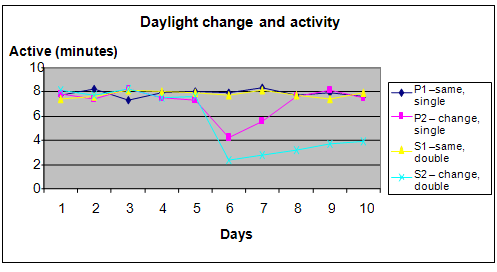| Complexity level: | 7 |
| Project cost ($): | 40 |
| Time required: | 1 day to prepare, 10 days for the science project experiment |
| Material availability: | Hamsters may be purchased from a pet store |
| Safety concerns: | Wear gloves to prevent injury when handling the hamsters |
Hypothesis
Single hamsters adjust more quickly to changes in daylight.
Overview
Biological clocks
All of us lead our lives according to a biological clock. This applies to people, animals and yes, plants. Our biological clock tells us when we should rise, take our meals, perform our chores and go to bed. Our bodies become adjusted to these routines which become “programmed” into our biological clock.
This biological clock can also be reset as and when the need arises. This happens, for example, when we travel overseas to different time zones. What is seen by our eyes and what is felt by our bodies will not be in agreement. The normal rhythm of eating working and sleeping is disturbed and it may take a few days for the body to adjust to the new time zone/routine. Another example of resetting the biological clock is when a person works night shifts. They will cease their normal pattern and adjust their biological clocks to sleep in the day and work at night.
When experiencing jet lag or adjusting to new work shifts, a person may suffer from symptoms like being unable to sleep, loss of appetite, headaches or depression. This is because our biological clock has programmed our body to regulate our sleep times, food digestion, blood pressure levels, body temperatures and hormone secretions
Scientific Terms
Materials
The materials required for this science fair project:
- 2 closed rooms
- 4 hamster cages with exercise wheel
- 6 hamsters
- 2 lamps with timers
- 2 dim red LED nightlights
- 2 stopwatches
- 2 assistants
Procedure
1. For this science fair project, the independent variable is whether the hamsters were examined alone, or in pairs, in the cage. The dependent variable is the average amount of time the hamsters spent on the exercise wheels. This is determined by observation and recording the timing using the stopwatch. The constants (control variables) are the shift in the daylight hours, the number of hamsters used and number of daylight hours.
2. The cages are labeled P1, P2, S1 and S2. One hamster is placed in each of the cages labeled P1 and P2. Two pairs of hamsters are placed in the cages marked S1and S2.
3. For the first 5 days, the cages are kept in the same room and the lights are turned on for 12 hours and off for the balance 12 hours. When the lights are off, the dim red LED lights are turned on. The average amount of time spent by the hamsters on the exercise wheel within a period of one hour, is calculated and recorded in the table below.
For a single hamster, Average time on wheel = Total amount of time the wheel is used / 1 hamsters (minutes)
For paired hamsters, Average time on wheel = Total amount of time the wheel is used / 2 hamsters (minutes)
4. On the sixth day, when the lights are switched off for after 12 hours, the hamsters in cage P2 and S2 are transferred to the second room. They are allowed to stay in the dark for 1 hour before the light is switched on again for the next 12 hours and after that, turned off for 12 hours (remember to turn on the dim red LED lights). The hamsters in cages P2 and S2 will follow this new schedule for the next 5 days. The average time spent by the hamsters on the exercise wheel per day is calculated as shown in procedure 3 and recorded in the table below.
5. The hamsters in caqes P1 and S1 should follow their original “day” schedule. Record the average time spent by them on the exercise wheel .

Results
It was observed that the hamsters in cages P1 and S1, did not show any significant behavioral change. However the hamsters in S2 had adjusted quickly to the daylight changes while the hamsters in P2 were slower to adapt to the change.
|
Hamster Group |
Average time spend by hamster on the wheel (minutes) |
|||||||||
|
1 |
2 |
3 |
4 |
5 |
6 |
7 |
8 |
9 |
10 |
|
|
P1 –same, single |
7.7 |
8.2 |
7.3 |
7.9 |
8.0 |
7.9 |
8.4 |
7.7 |
7.9 |
7.6 |
|
P2 – change, singe |
7.8 |
7.4 |
8.2 |
7.5 |
7.3 |
4.2 |
5.6 |
7.6 |
8.1 |
7.5 |
|
S1 –same, double |
7.4 |
7.6 |
8.1 |
8.0 |
7.9 |
7.7 |
8.1 |
7.7 |
7.4 |
7.9 |
|
S2 – change, double |
8.1 |
7.7 |
8.2 |
7.5 |
7.6 |
2.4 |
2.8 |
3.2 |
3.7 |
3.9 |
The graph below represents the results of our science experiment

Conclusion
The hypothesis that single hamsters adjust faster to changes in daylight is proven to be true.
The biological clock is believed to be an important part of the evolution and survival of species. Nocturnal animals with poor vision in the day, are biologically “programmed” to hide and sleep during the day, so that they are not vulnerable to their predators.
Also consider
What would happen if this science fair project were to be repeated using different types of animals like mice or cats?
The science project can be repeated to evaluate different activities like sleeping and feeding times.
References
Jet lag - http://en.wikipedia.org/wiki/Jet_lag
Do pets suffer jet lag - http://animals.howstuffworks.com/pets/pet-travel/pets-suffer-jet-lag.htm
What is your biological clock? - http://www.essortment.com/all/clockbiological_rtpx.htm

